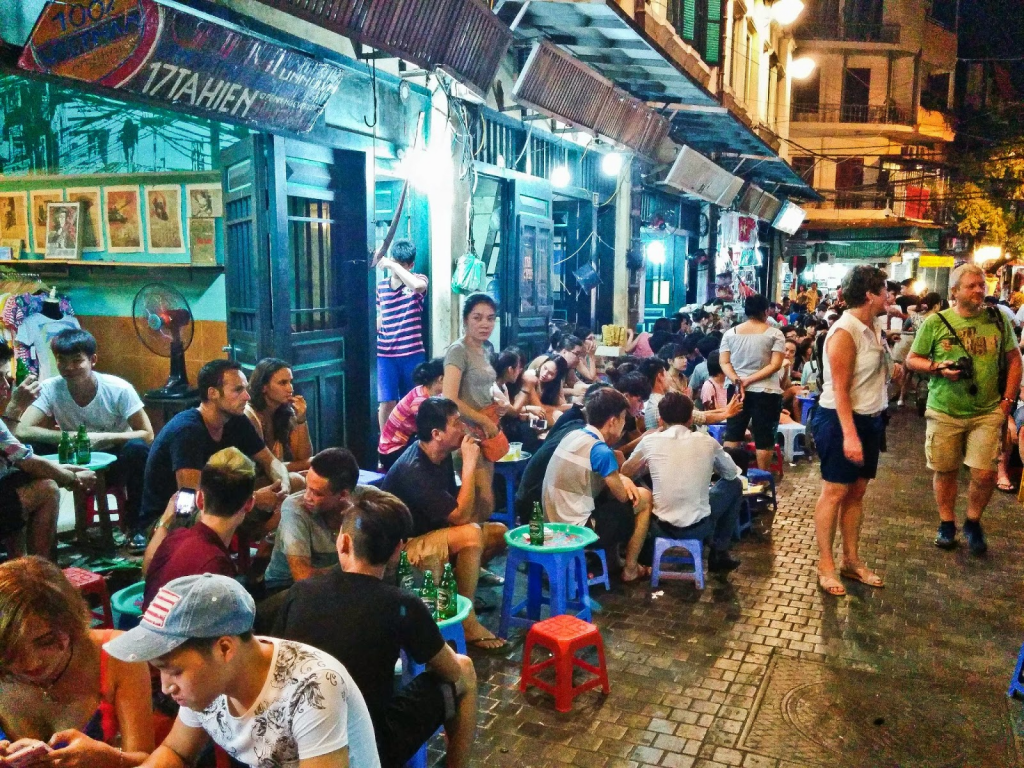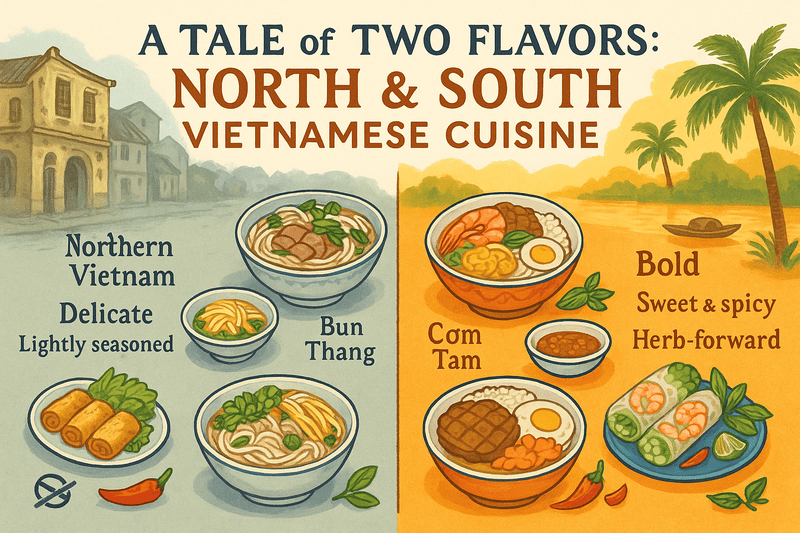Vietnam, a country of profound cultural depth and stunning geographical diversity, presents a culinary landscape as varied as its scenery. While a shared language and national identity bind the North and South, their food cultures tell remarkably distinct stories. Travelers often arrive with a singular image of Vietnamese cuisine, only to discover that Phở in Hanoi tastes quite different from Phở in Saigon. This fundamental distinction is just the beginning of a rich gastronomic exploration.
At Saigon Food Tour, we hold a deep conviction: food offers the most authentic gateway to understanding a nation. In Vietnam, this rings especially true. This blog aims to guide you through the defining flavors, essential ingredients, unique cooking styles, and even the underlying philosophies that delineate Northern from Southern Vietnamese cuisine. Along the way, we’ll weave in personal anecdotes from our cherished guests and dedicated team, allowing you to truly “taste the difference” even before your journey begins.
Geography on a Plate: Where Climate Shapes Cuisine
The very climate of Vietnam profoundly influences what thrives in its kitchens.
Northern Vietnam (including Hanoi, Ha Long, and Sapa) experiences a cooler, more seasonal climate. This leads to shorter growing seasons and a more limited availability of certain herbs and tropical fruits. The North’s historical proximity to China has also woven subtle influences into its culinary fabric, favoring a more refined and often less ornate approach.
Conversely, Southern Vietnam (Saigon, the Mekong Delta) basks in a warm, tropical climate year-round. This geographical blessing, coupled with the rich, fertile soil of the Mekong Delta, fosters an extraordinary abundance of fruits, herbs, and vegetables. Southern cuisine also carries the echoes of historical interactions, bearing influences from Cambodian, Indian, French, and Cham culinary traditions, which contribute to its vibrant and diverse palette.
As one guest from Denmark beautifully articulated after sampling fresh jackfruit and star apple on our tour, “You can taste the sunshine in this fruit. It’s like your food is always celebrating!” This sentiment perfectly captures the spirit of Southern Vietnamese cuisine.
Flavor Profiles: A Dance of Balance and Boldness
The divergence in flavor profiles is perhaps the most striking difference between the two regions.
| Region | Main Flavor Characteristics |
| North | Subtle, clean, mild, and balanced. Characterized by minimal sugar and a foundational saltiness from fish sauce. |
| South | Bold, sweet, spicy, rich in fresh herbs and vegetables. Frequently features coconut-based elements. |
Northern Vietnamese cuisine gracefully prioritizes harmony. Dishes are often lighter and more restrained, designed to allow individual ingredients to shine without overwhelming one another. In stark contrast, the South embraces boldness: a more generous hand with sugar, a wider array of fresh herbs, a stronger presence of chili, and a more pronounced use of fish sauce define its vibrant character.
“In Hanoi, even Phở feels serious—quiet, composed. It’s a dish to be contemplated,” shares Anh, one of our most experienced tour guides. “In Saigon, the same dish is louder, friendlier, and a bit sweet, like a big, warm hug. It invites you in.”
The Pho-nomenon: North vs. South Pho
The beloved national dish, Phở, offers a perfect illustration of this regional culinary divide.
Northern Phở (Phở Hà Nội) is celebrated for its clear, savory broth, which is the undisputed star of the show. It typically comes with minimal toppings, primarily green and white onions, and notably, without bean sprouts or hoisin sauce. It’s traditionally enjoyed with quẩy (fried dough sticks), perfect for dipping into the exquisite broth.

Southern Phở (Phở Sài Gòn) features a slightly sweeter broth, reflecting the region’s preference for a bolder flavor profile. It arrives generously garnished with a vibrant array of fresh herbs, including Thai basil, bean sprouts, lime wedges, and sliced chilies. Hoisin and chili sauce are almost always provided on the side, allowing diners to customize their bowl to their exact preference. Southern Phở is inherently more colorful and dynamic.

👀 Insider Tip: On our food tours, guests frequently rave about the opportunity to try both styles back-to-back. We often arrange a small comparison tasting; it’s always a memorable highlight!
The Verdant Embrace: Use of Herbs and Vegetables
When it comes to fresh produce, the South truly emerges as the herb garden of Vietnam.
Southern cuisine frequently presents a “garden on the side”—heaping plates brimming with an astonishing variety of fresh herbs: aromatic basil, vibrant coriander, pungent fish mint, sawtooth herb, and many more. These herbs are not mere garnishes; they are integral components, contributing layers of fresh, bright flavor to every bite.
Northern dishes, by contrast, are more modest in their herb usage. Green onions, perilla, and a touch of coriander are typically used sparingly, adding subtle notes rather than defining the dish.
🌿 As one Australian guest enthusiastically remarked, “I think I just ate five types of leaves I’ve never seen before—but I loved them all!” That, in essence, is the Southern way: flavor amplified through unparalleled freshness.
Signature Dishes: A Taste of Each Region’s Soul
Each region proudly offers its own collection of iconic dishes, each telling a unique story.
Northern Must-Try Dishes:
- Phở Bò (Beef noodle soup): The quintessential Northern rendition, focusing on broth purity.
- Bún Thang (Delicate chicken noodle soup): A complex, elegant noodle soup with a light, clear broth and a medley of ingredients.
- Chả Cá Lã Vọng (Grilled fish with turmeric and dill): A Hanoi specialty, where fresh fish is marinated, grilled, and served sizzling with dill and scallions.
- Xôi (Sticky rice with toppings): A versatile and comforting staple, often enjoyed for breakfast.
- Nem Rán (Northern-style spring rolls): Crispy fried spring rolls, typically smaller and with a distinct filling.

Southern Must-Try Dishes:
- Bánh Xèo (Crispy rice pancake with pork and shrimp): A large, savory crepe, often filled with a vibrant mix of ingredients and served with an abundance of fresh herbs.
- Cơm Tấm (Broken rice with grilled pork): A beloved Saigon street food, featuring fragrant broken rice topped with succulent grilled pork, an egg, and other savory delights.
- Bún Thịt Nướng (Grilled pork with rice vermicelli): A refreshing bowl of vermicelli noodles, grilled pork, fresh herbs, and a savory dipping sauce.
- Hủ Tiếu Nam Vang (Cambodian-style noodle soup): A hearty and flavorful noodle soup with a rich broth, often containing pork, shrimp, and offal.
- Gỏi Cuốn (Fresh spring rolls): Light and refreshing rice paper rolls filled with vermicelli, herbs, and usually shrimp or pork, served with a peanut dipping sauce.

🍽️ Our guests frequently declare Bánh Xèo their absolute favorite stop on our tours. It’s crispy, interactive, utterly delicious when wrapped with herbs and dipped in fish sauce—a flavor explosion you truly won’t forget.
Soups and Noodles: Comfort in Every Bowl, Varied Styles
Vietnamese cuisine’s profound love for noodles is universal, yet the styles of preparation vary significantly by region.
In the North, broth-focused dishes like Phở and Bún Thang are masterpieces of clarity and depth. The emphasis is on long-simmered broths that achieve a sublime purity of flavor.
In the South, broths are often richer and more layered, frequently incorporating influences like coconut milk or seafood. Dishes like Hủ Tiếu or Bún Mắm offer a more complex and robust flavor profile, often with a hint of sweetness.
🍜 We once had a French guest, overcome with emotion, actually cry after trying Bún Mắm. She exclaimed, “It tastes like the ocean and a backyard BBQ had a baby!” Such is the transformative power of Southern Vietnamese flavors.
Street Food Culture: A Symphony of Sights, Sounds, and Smells
While both regions share a vibrant street food culture, the experience itself differs in pace and energy.
Hanoi’s street food scene tends to be quieter, a more contemplative affair often enjoyed on tiny stools tucked away in intimate alleyways. Here, you’ll find grilled meats, comforting sticky rice dishes, and simple yet profoundly flavored delicacies.

Saigon’s street food scene, by contrast, is a loud, bright, and exhilarating spectacle. It’s a buzzing symphony of scooters, flashing neon signs, and the irresistible aromas of sizzling pancakes and grilling pork that fill the humid night air.

🛵 Our night tours truly feel like a street food safari. You often hear the sizzle of a wok or the crackle of a grill before you even spot the vendor. It’s a wild, sensory experience, and our guests absolutely adore that infectious energy.
Sweet Treats and Refreshing Drinks
Even in the realm of desserts and beverages, distinct regional preferences emerge.
Northern Sweets:
- Chè Bà Cốt: A comforting ginger sticky rice pudding, often enjoyed during cooler months.
- Bánh Cốm: Delicate green rice cakes with a sweet mung bean paste filling, embodying the subtle elegance of Northern flavors.

Southern Sweets:
- Chè Thái: A vibrant and colorful dessert featuring an assortment of fruits, jellies, and sometimes coconut milk, a true celebration of tropical abundance.
- Rau Câu Dừa: Refreshing coconut jelly, a light and popular treat.
- Sinh Tố: Creamy fresh fruit smoothies, often enhanced with condensed milk, perfect for the tropical climate.

🥤 We always make sure to conclude our tours with something wonderfully refreshing—whether it’s a rich avocado smoothie or a visit to a bustling street-corner chè stand. It’s the sweetest, most satisfying way to wrap up the night.
Cultural Mindsets Around Food: More Than Just Sustenance
Beyond ingredients and techniques, the underlying cultural philosophy towards food also varies significantly.
In the North, food can be deeply tied to ceremony and tradition. Meals often follow a more structured and formal pattern, reflecting a reverence for heritage and communal dining rituals.
In the South, food is primarily about fun, family, and freedom. It’s expressive, abundant, and often a lively, spontaneous affair. There’s an inherent generosity in Southern cooking, an insistence on ensuring everyone is well-fed and joyful.
“One of our regular guests from New Zealand articulated it perfectly,” our team recounts. “He said, ‘Southern Vietnamese food feels like your grandma is feeding you. She’s loud, she’s laughing, and she absolutely insists you eat more!'”
So… Which Region Has the Best Food?
The answer, delightfully, is that it’s not a competition—it’s a journey.
Each dish, whether from the cool North or the tropical South, tells a compelling story of its landscape, culture, history, and the people who crafted it. The most enriching way to truly appreciate this profound culinary contrast is to embark on your own gastronomic adventure, eating your way from North to South, or vice versa.
However, if you find yourself in Saigon right now, we wholeheartedly invite you to immerse yourself in the bold, vibrant, and incredibly diverse flavors that define Southern Vietnam with us.
✨ Final Thoughts: Experience Southern Flavors with Saigon Food Tour
Whether you’re a devoted foodie, a first-time visitor to this incredible country, or simply a curious traveler, Saigon’s street food scene promises to captivate and astound you. And now that you understand the nuanced ways it differs from the North, your appreciation for its unique character will only deepen.
Join us for our Taste of the Night motorbike food tour and let our passionate local guides introduce you to the dishes that truly define the soul of Southern Vietnam. It’s far more than just a meal—it’s a vibrant, unforgettable memory waiting to be made.
👉 Book your food adventure now at https://saigonfoodtour.com/ or reach out to us via WhatsApp or Instagram.
We’ll save you a seat—and perhaps a delightful coconut jelly dessert, too. 😉

